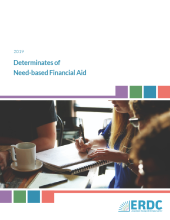This study is about the amount of need-based financial aid awarded to college students compared to their financial need. It involves a group of students who entered public higher education in Washington State in the first year after their high school graduation. They all received need-based financial aid in the first year of attending college. The students were followed for six years. They differed in the amounts of financial aid they received relative to their financial need. This study is an attempt to identify the key determinates as to why some students received more aid than others. Study highlights include:
- For students who begin postsecondary education at a public 4-year institution, the primary factors associated with the total level of need-based financial aid relative to need are:
- Academic ability as measured by their high school GPA (students with higher GPAs received more aid in relation to their need).
- Whether or not they attended full-time (full-time students received more aid in relation to their need).
- Family income (students who had higher expected family contributions had less of their financial need met by aid and, conversely, students from poorer families received more aid relative to their need).
- The relative poverty of the high school from which the student graduated (students from high schools with higher shares of students eligible for free or reduced-price lunches received more aid relative to their need).
- Independence (students who became independent from their parents for financial aid purposes received less aid relative to need).
- Institutional financial aid (students attending institutions that on average provided higher levels of grant aid per all undergraduate students received more aid relative to their need).
- Race/ethnicity (for men being African-American meant more aid compared to need; for women being Hispanic or African-American meant more aid compared to need).
- For students who begin postsecondary education at a public community or technical college (CTC), the important factors associated with relatively higher amounts of total need-based financial aid included:
- Attending full-time (full-time students received more aid compared to need; part-time students received lesser amounts of aid compared to need).
- Transferring to a 4-year institution (on average students attending a 4-year institution received more aid than students attending a CTC; this holds even for students who start at a CTC and then transfer to a 4-year institution).
- Academic ability as measured by their high school GPA (as with 4-year students, a higher GPA means more aid relative to need).
- Independence (women who were at some point became independent of their parents for financial aid purposes received less financial aid relative to need).
- Free or reduced price lunch (FRPL) eligible (students that were eligible sometime during high school for free or reduced-price lunches received more aid relative to need).


